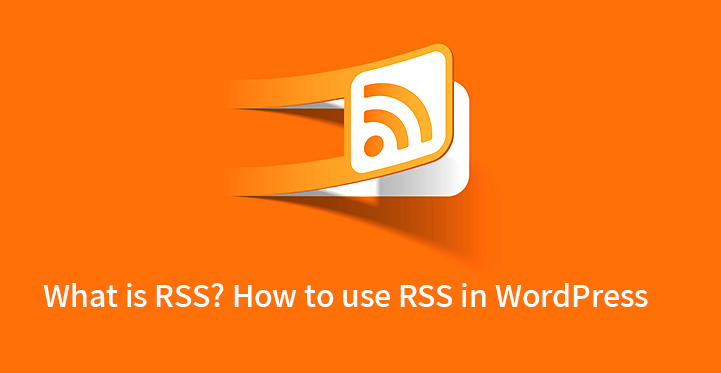If you are using WordPress CMS as an environment for your publishing purposes, you have probably already heard of RSS and the benefits of using it.
Table of Contents
Now, if you are scouring the Internet for the easy to understand and follow material specifying what RSS is and how to use RSS in WordPress, you have come to the right place.
On the whole, it’s a simple and effective time tested technology which will not require any efforts to work stunningly on your WordPress website.
First of all, let’s see what RRS is and which the benefits of using and optimizing RRS or news feeds of your website or blog are.
What is RSS?
RSS stands for Really Simple Syndication or Rich Site Summary. It is one of the standardized formats used to transfer information over the network and is often referred to as news feed.
Speaking less technologically, it’s a convenient way to receive the latest news and updates from your favorite websites and blogs without having to visit them constantly, thus saving your precious time.
Once you have subscribed to this or that site’s RSS feed, the content of that particular site is going to automatically passed to you and you can keep the track of it in your feed reader, mailbox or in some other device you are using.
The transmission of web content in this case is known as web syndication and enables websites to use well structured XML documents to published their information, either fully or partly in a summarized way like blog entries and articles, titles and headlines, video and audio materials, deals and special offers, etc.
What are the advantages that can persuade you to use RSS in WordPress?
Well, what is the real benefit of RSS for the users? Suppose you read fifteen interesting blogs and want to know whenever they are updated with fresh content or articles or, more conveniently, want to read all of such updates in one place.
Most of the blogs offer subscription for updates via email, but believe us, it’s not the most convenient way to get separate email for each update. The problem can be solved with the help of subscription websites, but not all the websites and blog support such subscriptions.
This is when RSS feeds come to the aid. All you need to choose is a proper RSS reader or app, add RSS feeds from different sites and blogs you follow, and you are free to get the latest updates and news from those portals in a convenient mode.
As you can see, enabling RSS feeds on your WordPress website is one of the reasonable things to do free your audience from email overload and let them get the news they are waiting for much simpler and interesting.
RSS feeds have several other advantages for the publishers as well. It helps them spread a message around their army of fans and followers easily, build a stronger community around their online profile, bring more people back to their blogs and websites, etc.
How to use RSS in WordPress?
Expanding your audience with the help of syndication is what WordPress enables you by default. WordPress is first and foremost designed for blogs and information sites.
Therefore, by default, the functionality of RSS feeds is included. What remains is only to understand how to configure and make it more beautiful.
If you have never disabled RSS in your WP website, it means RSS feeds are automatically generated. However, the bad news is that you don’t have a total control over them when it comes to optimizing these feeds for your readers and subscribers.
There are 2 practical ways to use RSS in WordPress and configure it as per your needs. One is through plugins/software and the other is through manual code editing.
For example, if you have miniature images assigned to your posts and want to add them to the feed, you need to add the following lines of codes to your functions.php file:
function img_rss($content) {
global $post;
if ( has_post_thumbnail( $post->ID ) ) {
$content = ” . get_the_post_thumbnail( $post->ID, ‘thumbnail’, array( ‘style’ => ‘float:left; margin:0 10px 10px 0;’ ) ) . ” . $content;
}
return $content;
}
add_filter(‘the_excerpt_rss’, ‘img_rss’);
add_filter(‘the_content_feed’, ‘img_rss’);
If you want to manually change the appearance of the feed, then paste the following code into functions.php file:
function acme_product_feed_rss2( $for_comments ) {
$rss_template = ‘new_rss.php’;
load_template( $rss_template );
}
remove_all_actions( ‘do_feed_rss2’ );
add_action( ‘do_feed_rss2’, ‘acme_product_feed_rss2’, 10, 1 );
Further, take feed2.php file in the root directory and resave it as new_rss.php. Now any changes in the file new_rss.php will directly affect the appearance of the feed. E.g., you can remove the author’s name, link to comments, manage the post content and so on.
Related Post:How to Fix WordPress RSS Feed Errors?
The second way is to use third party software for the management and optimization of your RSS feeds.
Although many specialists argue that FeedBurner is a dying product and one must find alternatives to it, it’s still one of the most popular and free tools you can use to burn your feeds.
Feedzy RSS Feeds Lite is one of the sophisticated plugins enabling you to use RSS in WordPress in your posts, pages or custom content types.
RSSI Import is developed to make your work with WordPress feeds much easier with the help of a widget or a shortcode (or a PHP function). There is nothing bewildering about this easy to use yet effective plugin when it comes to importing RSS feeds and customizing every single thing you need.
Related Post:10 Tips To Improve Your WordPress RSS Feed
Category Specific RSS Feed Subscription:
Category Specific RSS Feed Subscription is an ideal tool to take care of your subscribers and provide them with multiple RSS feed subscription options they can choose from.
Easily create category specific RSS Feeds and let your readers subscribe to choose the topics and news they are mainly interested in and subscribe to them.




